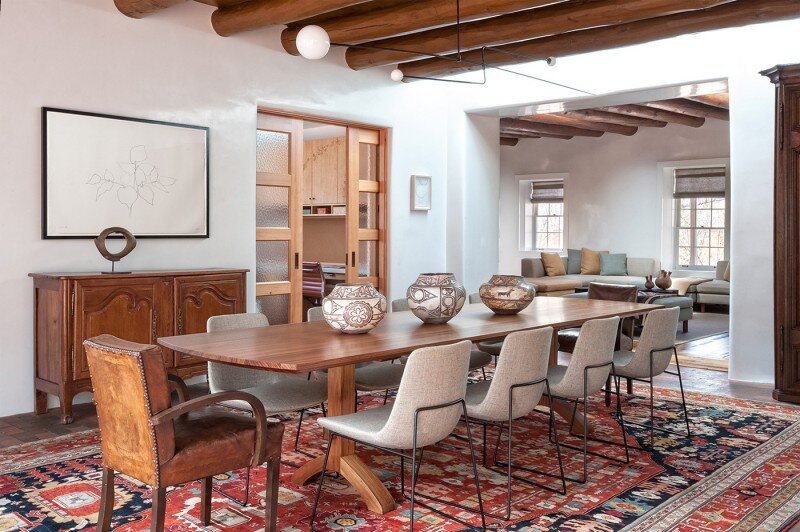— do-it-yourself —
CARE & MAINTENANCE
image courtesy of Emily Henry Interiors
conservation
Learn to observe the condition of rugs and textiles in your collection, and make sure they are receiving proper treatment. Most problems can be addressed if caught early, but some damage can be irreversible if caught too late. Of special concern are insect damage, mildew, light/heat damage, excessive build-up of stains and soiling, excessive wear, and fiber damage from over-washing, chemical exposure, and soap build-up.
The four major threats to long-term conservation of oriental and Navajo rugs are: moisture, sunlight/ultraviolet exposure, insect damage, and improper cleaning.
1. Moisture. Dampness from flooding, leaks, potted plants, and condensation can cause mildew, rot, bleaching, and degradation of fibers. Any wetting should be dried immediately–a carpet cleaning or flood restoration service can be helpful in extracting water, but make sure an experienced Navajo or oriental rug professional does the cleaning. Some exceptionally damp environments are not compatible with the long-term care of antique textiles.
2. Sunlight/ultraviolet light and heat. Especially in the high desert southwest, sunlight will cause irreversible fading of colors and accelerate degradation of fibers. If you are placing a rug near direct sunlight, windows should be filtered with 100% UV protection. Also, radiant heat installed in many newer homes can accelerate fiber degradation, especially in antique and luster-washed contemporary rugs.
3. Insects. Wool moths can infest any wool or animal fiber if it is dirty, in dark or undisturbed areas, or not checked regularly. The most vulnerable pieces are those hanging on walls, stored without protection in dark areas, or placed with furniture covering them so that they cannot be properly vacuumed or inspected. Other damaging insects include beetles and silverfish. Never use moth balls, moth crystals, or pesticide sprays, which can all damage fibers and dyes. Cleanliness and good housekeeping are the best preventative.
4. Improper cleaning. It is actually better not to clean a rug than to have it improperly cleaned. High temperature solutions, high suction vacuums, high alkaline cleansers, and incomplete rinsing/soap residue build-up are all common and serious problems caused by commercial cleaning. Inexperienced rug washers can cause color run, buckling, mildew buildup, crusty fringes, tears, over-washing/scrubbing/bleaching of stains, and other often irreversible problems. Get referrals from trusted dealers or conservators for a trustworthy rug cleaner in your area, or contact us at Textival.
Household pets, vacuum cleaners, metal sculpture/furniture legs, and heavy traffic can all do serious damage to floor rugs as well.



Selection/placement of rugs and textiles
With floor rugs, choose a rug that is most suitable for its location (or a location suitable for the rug). A rug should not receive more wear than its condition or structure will allow. Stairs and entrance-ways are particularly problematic locations, requiring strong pile rugs, or rugs of little value. Dining room chairs are not compatible with a worn rug or old flat-woven rug. It is advisable to turn rugs occasionally in order to even out wear and exposure. A judicious placement of furniture can protect weak areas. Navajo rugs, old kilims, and antique low-pile carpets should be kept away from high-traffic areas. Direct sunlight will fade and shorten the life of rugs, and there is evidence that radiant heat can be damaging to antique (and 'antiqued') rugs.
Rug padding
Always use a rug pad designed specifically for oriental and Navajo rugs. Proper underlay lengthens the life of the rug by absorbing the friction that causes wear. Do not use foam cushion pads or cheap non-slip pads, which will not protect the rug. Cheap pads can release oils and acids which can damage both rugs and floors. Textival offers several types of pads that can be custom cut for your rug.
Moth and insect problems
Prevention is the best solution to insect problems, and this requires careful vacuuming and regular visual checking of stored and out-of-the-way weavings. Wool-eating moths thrive in dark and undisturbed areas, while other destructive beetles and silverfish usually do damage when items are left on the floor or stored in hard-to-reach and dirty areas.
Signs of wool moth infestation include small (1/4 - 1/3 inch) beige flying moths, spider-like webbing on wool surfaces, small cocoons and/or larvae, and grazing, holes and/or tunneling in woolens. Flying moths lay eggs on wool, fur and feather, and when these eggs hatch, the new larvae begin their most damaging life stage by grazing on the fibers. Repeated life cycles and generations will destroy large areas of a weaving.
If you determine that an item has been infested, first remove it from the vicinity of other wool textiles, being careful not to shake loose any eggs or insects that could remain and do more damage. Carefully vacuum both surfaces of the item, focusing on areas with webbing residues, eggs, or damage. Then discard or clean out the vacuum bag, as moths can hatch inside a vacuum canister and get out. Sunlight or home freezing can pause the life-cycle, but is not a long term solution.
Moth crystals (PDB) can be used judiciously to kill moth larvae and adults in extreme cases, but should not be allowed to touch the item (PDB crystal fumes are heavier than air, and are only effective when the item is at the bottom of a closed system such as a polyethylene garbage can or sealed storage box).
In most cases of insect infestation, the services of a professional cleaning service are recommended to remove any eggs in the weaving and to clean the item, thereby discouraging re-infestation.
Textival offers a non-toxic silica-based fiber seal treatment for Navajo rugs and tapestries/kilims that can be applied as a deterrent after washing. Most other ‘moth-proofing’ treatments are either very temporary or hazardous to textiles and the environment.

